Antimicrobial Polymers in Additive Manufacturing: Detailed Analysis
VerifiedAdded on 2023/03/23
|7
|2497
|75
Report
AI Summary
This report discusses the advancements in using antimicrobial polymers in additive manufacturing (AM) for creating 3D-printed objects with antimicrobial properties. It highlights two main approaches: using natural polymers with inherent antimicrobial capabilities and employing synthetic polymers modified with antimicrobial groups or incorporating antimicrobial agents. The report emphasizes the increasing demand for AM in regenerative medicine and antimicrobial devices, enabling the creation of complex geometries for customized applications like orthopedic implants and drug delivery systems. It addresses the challenges of material contamination and biofilm formation, outlining various techniques for manufacturing antimicrobial items using both natural and synthetic polymer compounds. Furthermore, it evaluates the toxicity of materials used in AM, particularly SLA resins, and concludes by underscoring the potential of antimicrobial polymers to reduce infection risks in medical applications, while also pointing out the need for further research to address existing limitations. Desklib offers a wealth of resources, including solved assignments and past papers, to aid students in their studies.
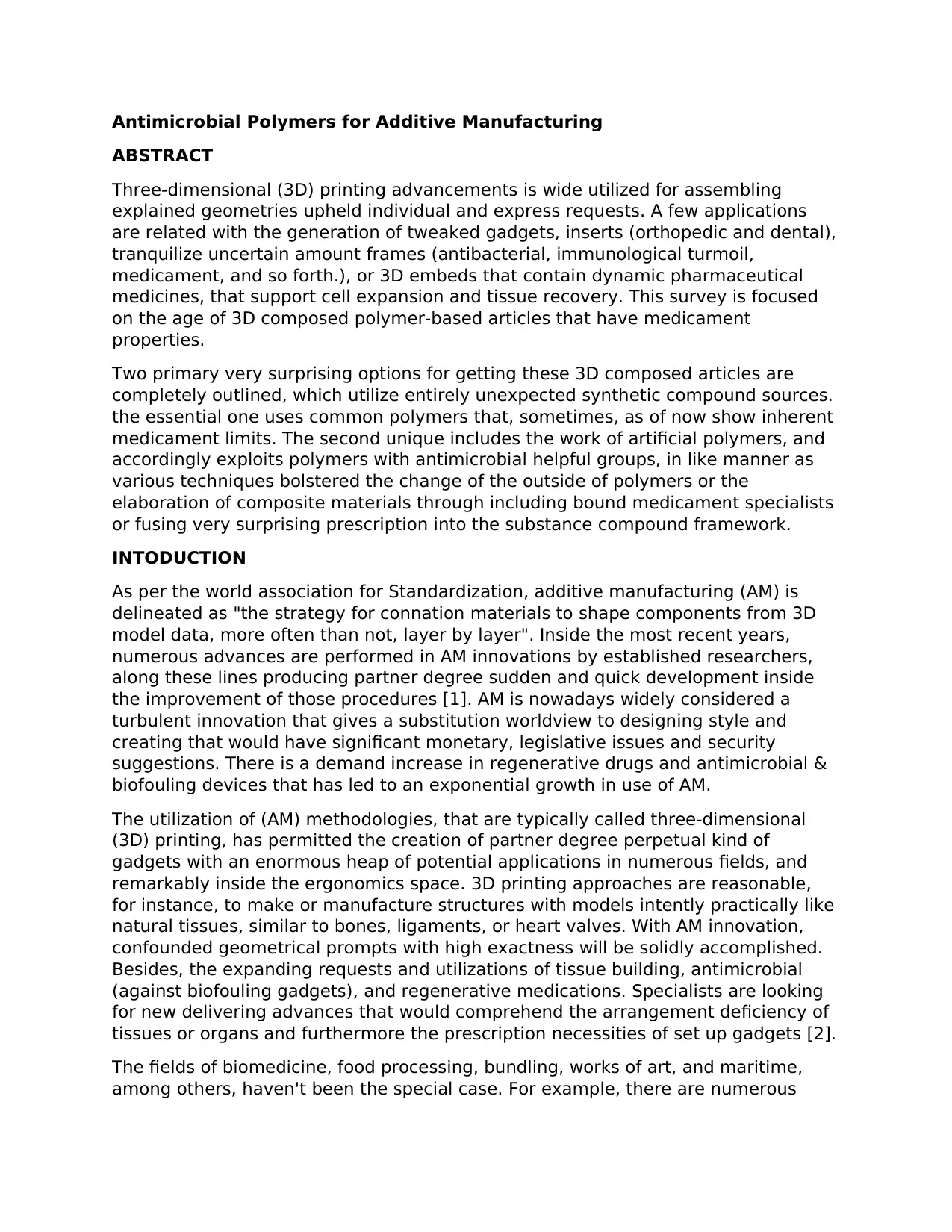
Antimicrobial Polymers for Additive Manufacturing
ABSTRACT
Three-dimensional (3D) printing advancements is wide utilized for assembling
explained geometries upheld individual and express requests. A few applications
are related with the generation of tweaked gadgets, inserts (orthopedic and dental),
tranquilize uncertain amount frames (antibacterial, immunological turmoil,
medicament, and so forth.), or 3D embeds that contain dynamic pharmaceutical
medicines, that support cell expansion and tissue recovery. This survey is focused
on the age of 3D composed polymer-based articles that have medicament
properties.
Two primary very surprising options for getting these 3D composed articles are
completely outlined, which utilize entirely unexpected synthetic compound sources.
the essential one uses common polymers that, sometimes, as of now show inherent
medicament limits. The second unique includes the work of artificial polymers, and
accordingly exploits polymers with antimicrobial helpful groups, in like manner as
various techniques bolstered the change of the outside of polymers or the
elaboration of composite materials through including bound medicament specialists
or fusing very surprising prescription into the substance compound framework.
INTODUCTION
As per the world association for Standardization, additive manufacturing (AM) is
delineated as "the strategy for connation materials to shape components from 3D
model data, more often than not, layer by layer". Inside the most recent years,
numerous advances are performed in AM innovations by established researchers,
along these lines producing partner degree sudden and quick development inside
the improvement of those procedures [1]. AM is nowadays widely considered a
turbulent innovation that gives a substitution worldview to designing style and
creating that would have significant monetary, legislative issues and security
suggestions. There is a demand increase in regenerative drugs and antimicrobial &
biofouling devices that has led to an exponential growth in use of AM.
The utilization of (AM) methodologies, that are typically called three-dimensional
(3D) printing, has permitted the creation of partner degree perpetual kind of
gadgets with an enormous heap of potential applications in numerous fields, and
remarkably inside the ergonomics space. 3D printing approaches are reasonable,
for instance, to make or manufacture structures with models intently practically like
natural tissues, similar to bones, ligaments, or heart valves. With AM innovation,
confounded geometrical prompts with high exactness will be solidly accomplished.
Besides, the expanding requests and utilizations of tissue building, antimicrobial
(against biofouling gadgets), and regenerative medications. Specialists are looking
for new delivering advances that would comprehend the arrangement deficiency of
tissues or organs and furthermore the prescription necessities of set up gadgets [2].
The fields of biomedicine, food processing, bundling, works of art, and maritime,
among others, haven't been the special case. For example, there are numerous
ABSTRACT
Three-dimensional (3D) printing advancements is wide utilized for assembling
explained geometries upheld individual and express requests. A few applications
are related with the generation of tweaked gadgets, inserts (orthopedic and dental),
tranquilize uncertain amount frames (antibacterial, immunological turmoil,
medicament, and so forth.), or 3D embeds that contain dynamic pharmaceutical
medicines, that support cell expansion and tissue recovery. This survey is focused
on the age of 3D composed polymer-based articles that have medicament
properties.
Two primary very surprising options for getting these 3D composed articles are
completely outlined, which utilize entirely unexpected synthetic compound sources.
the essential one uses common polymers that, sometimes, as of now show inherent
medicament limits. The second unique includes the work of artificial polymers, and
accordingly exploits polymers with antimicrobial helpful groups, in like manner as
various techniques bolstered the change of the outside of polymers or the
elaboration of composite materials through including bound medicament specialists
or fusing very surprising prescription into the substance compound framework.
INTODUCTION
As per the world association for Standardization, additive manufacturing (AM) is
delineated as "the strategy for connation materials to shape components from 3D
model data, more often than not, layer by layer". Inside the most recent years,
numerous advances are performed in AM innovations by established researchers,
along these lines producing partner degree sudden and quick development inside
the improvement of those procedures [1]. AM is nowadays widely considered a
turbulent innovation that gives a substitution worldview to designing style and
creating that would have significant monetary, legislative issues and security
suggestions. There is a demand increase in regenerative drugs and antimicrobial &
biofouling devices that has led to an exponential growth in use of AM.
The utilization of (AM) methodologies, that are typically called three-dimensional
(3D) printing, has permitted the creation of partner degree perpetual kind of
gadgets with an enormous heap of potential applications in numerous fields, and
remarkably inside the ergonomics space. 3D printing approaches are reasonable,
for instance, to make or manufacture structures with models intently practically like
natural tissues, similar to bones, ligaments, or heart valves. With AM innovation,
confounded geometrical prompts with high exactness will be solidly accomplished.
Besides, the expanding requests and utilizations of tissue building, antimicrobial
(against biofouling gadgets), and regenerative medications. Specialists are looking
for new delivering advances that would comprehend the arrangement deficiency of
tissues or organs and furthermore the prescription necessities of set up gadgets [2].
The fields of biomedicine, food processing, bundling, works of art, and maritime,
among others, haven't been the special case. For example, there are numerous
Paraphrase This Document
Need a fresh take? Get an instant paraphrase of this document with our AI Paraphraser
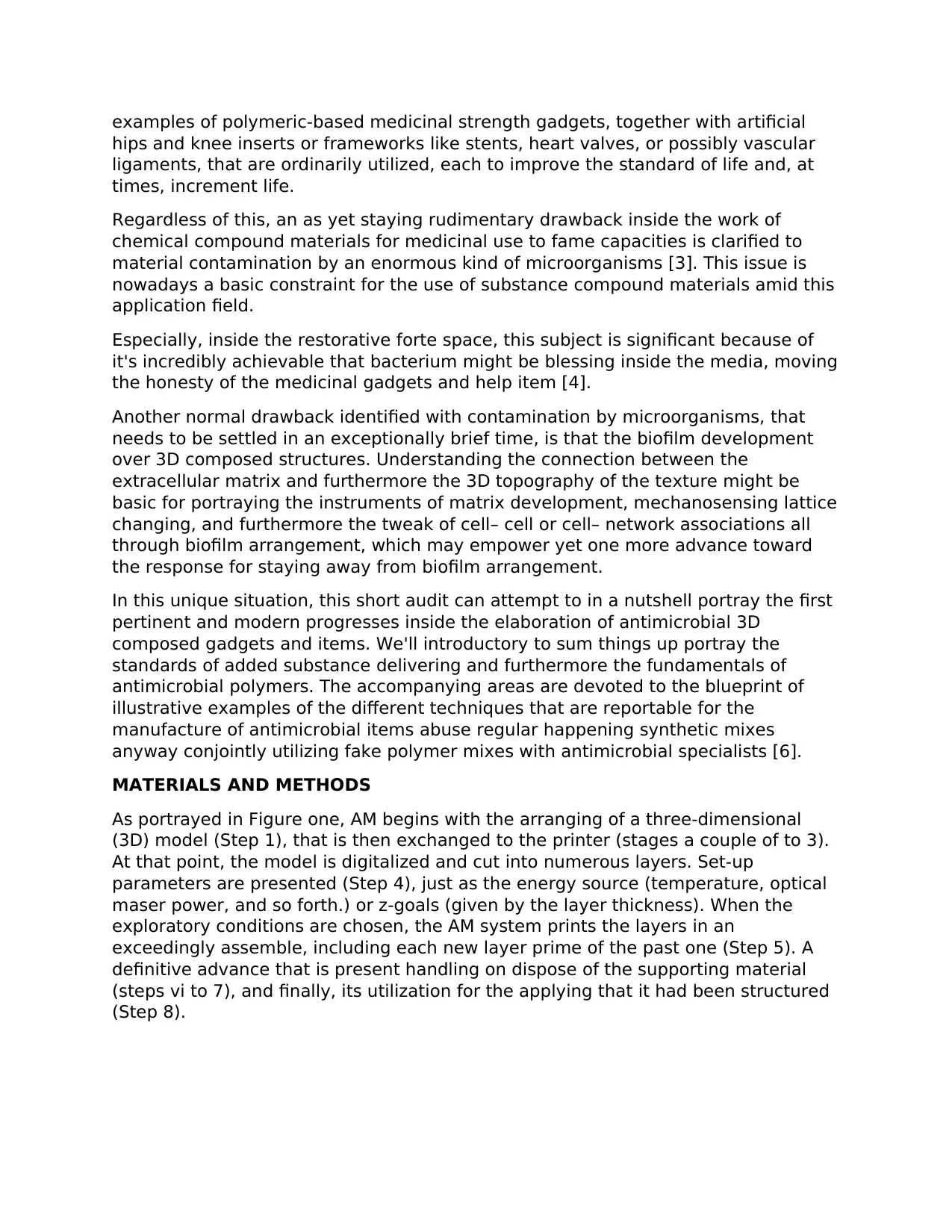
examples of polymeric-based medicinal strength gadgets, together with artificial
hips and knee inserts or frameworks like stents, heart valves, or possibly vascular
ligaments, that are ordinarily utilized, each to improve the standard of life and, at
times, increment life.
Regardless of this, an as yet staying rudimentary drawback inside the work of
chemical compound materials for medicinal use to fame capacities is clarified to
material contamination by an enormous kind of microorganisms [3]. This issue is
nowadays a basic constraint for the use of substance compound materials amid this
application field.
Especially, inside the restorative forte space, this subject is significant because of
it's incredibly achievable that bacterium might be blessing inside the media, moving
the honesty of the medicinal gadgets and help item [4].
Another normal drawback identified with contamination by microorganisms, that
needs to be settled in an exceptionally brief time, is that the biofilm development
over 3D composed structures. Understanding the connection between the
extracellular matrix and furthermore the 3D topography of the texture might be
basic for portraying the instruments of matrix development, mechanosensing lattice
changing, and furthermore the tweak of cell– cell or cell– network associations all
through biofilm arrangement, which may empower yet one more advance toward
the response for staying away from biofilm arrangement.
In this unique situation, this short audit can attempt to in a nutshell portray the first
pertinent and modern progresses inside the elaboration of antimicrobial 3D
composed gadgets and items. We'll introductory to sum things up portray the
standards of added substance delivering and furthermore the fundamentals of
antimicrobial polymers. The accompanying areas are devoted to the blueprint of
illustrative examples of the different techniques that are reportable for the
manufacture of antimicrobial items abuse regular happening synthetic mixes
anyway conjointly utilizing fake polymer mixes with antimicrobial specialists [6].
MATERIALS AND METHODS
As portrayed in Figure one, AM begins with the arranging of a three-dimensional
(3D) model (Step 1), that is then exchanged to the printer (stages a couple of to 3).
At that point, the model is digitalized and cut into numerous layers. Set-up
parameters are presented (Step 4), just as the energy source (temperature, optical
maser power, and so forth.) or z-goals (given by the layer thickness). When the
exploratory conditions are chosen, the AM system prints the layers in an
exceedingly assemble, including each new layer prime of the past one (Step 5). A
definitive advance that is present handling on dispose of the supporting material
(steps vi to 7), and finally, its utilization for the applying that it had been structured
(Step 8).
hips and knee inserts or frameworks like stents, heart valves, or possibly vascular
ligaments, that are ordinarily utilized, each to improve the standard of life and, at
times, increment life.
Regardless of this, an as yet staying rudimentary drawback inside the work of
chemical compound materials for medicinal use to fame capacities is clarified to
material contamination by an enormous kind of microorganisms [3]. This issue is
nowadays a basic constraint for the use of substance compound materials amid this
application field.
Especially, inside the restorative forte space, this subject is significant because of
it's incredibly achievable that bacterium might be blessing inside the media, moving
the honesty of the medicinal gadgets and help item [4].
Another normal drawback identified with contamination by microorganisms, that
needs to be settled in an exceptionally brief time, is that the biofilm development
over 3D composed structures. Understanding the connection between the
extracellular matrix and furthermore the 3D topography of the texture might be
basic for portraying the instruments of matrix development, mechanosensing lattice
changing, and furthermore the tweak of cell– cell or cell– network associations all
through biofilm arrangement, which may empower yet one more advance toward
the response for staying away from biofilm arrangement.
In this unique situation, this short audit can attempt to in a nutshell portray the first
pertinent and modern progresses inside the elaboration of antimicrobial 3D
composed gadgets and items. We'll introductory to sum things up portray the
standards of added substance delivering and furthermore the fundamentals of
antimicrobial polymers. The accompanying areas are devoted to the blueprint of
illustrative examples of the different techniques that are reportable for the
manufacture of antimicrobial items abuse regular happening synthetic mixes
anyway conjointly utilizing fake polymer mixes with antimicrobial specialists [6].
MATERIALS AND METHODS
As portrayed in Figure one, AM begins with the arranging of a three-dimensional
(3D) model (Step 1), that is then exchanged to the printer (stages a couple of to 3).
At that point, the model is digitalized and cut into numerous layers. Set-up
parameters are presented (Step 4), just as the energy source (temperature, optical
maser power, and so forth.) or z-goals (given by the layer thickness). When the
exploratory conditions are chosen, the AM system prints the layers in an
exceedingly assemble, including each new layer prime of the past one (Step 5). A
definitive advance that is present handling on dispose of the supporting material
(steps vi to 7), and finally, its utilization for the applying that it had been structured
(Step 8).
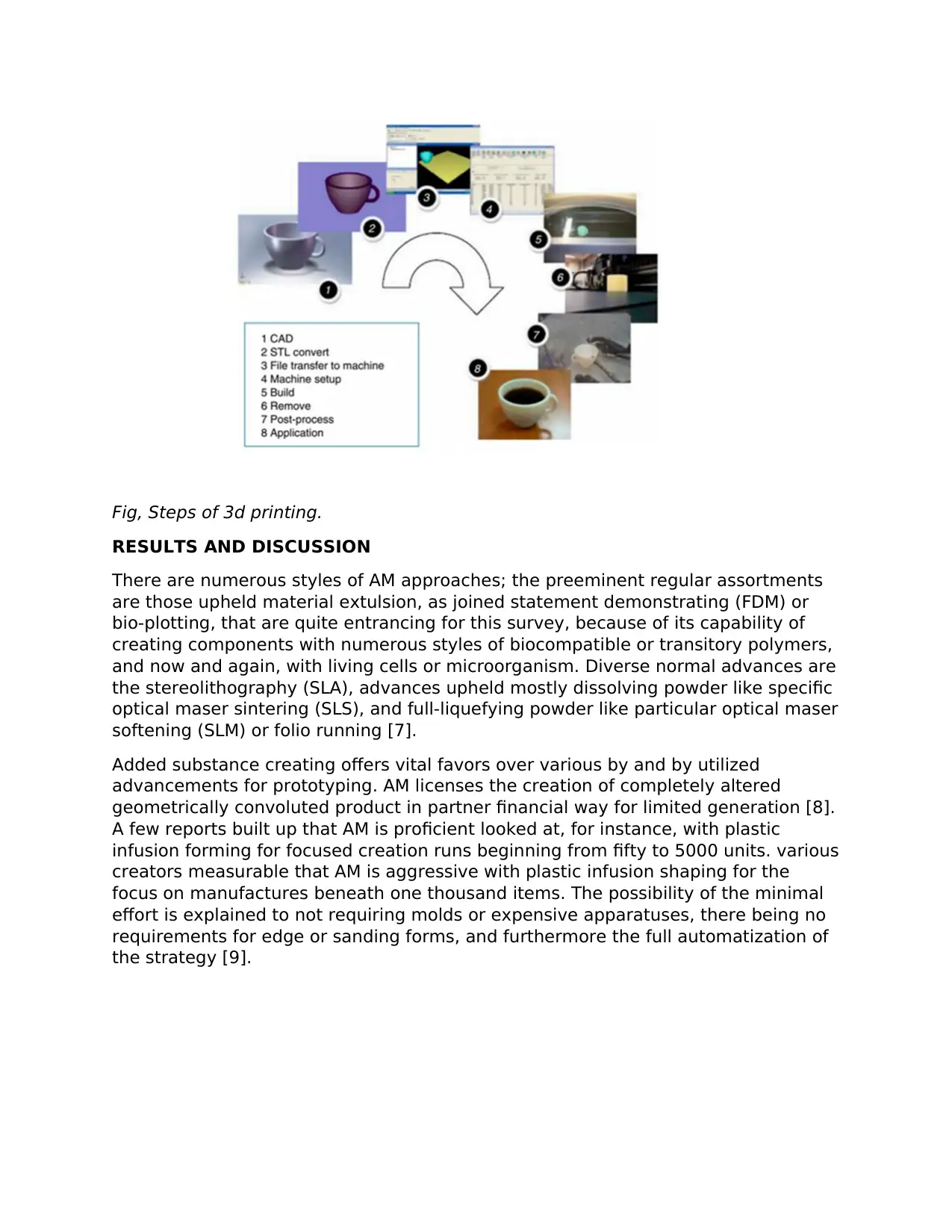
Fig, Steps of 3d printing.
RESULTS AND DISCUSSION
There are numerous styles of AM approaches; the preeminent regular assortments
are those upheld material extulsion, as joined statement demonstrating (FDM) or
bio-plotting, that are quite entrancing for this survey, because of its capability of
creating components with numerous styles of biocompatible or transitory polymers,
and now and again, with living cells or microorganism. Diverse normal advances are
the stereolithography (SLA), advances upheld mostly dissolving powder like specific
optical maser sintering (SLS), and full-liquefying powder like particular optical maser
softening (SLM) or folio running [7].
Added substance creating offers vital favors over various by and by utilized
advancements for prototyping. AM licenses the creation of completely altered
geometrically convoluted product in partner financial way for limited generation [8].
A few reports built up that AM is proficient looked at, for instance, with plastic
infusion forming for focused creation runs beginning from fifty to 5000 units. various
creators measurable that AM is aggressive with plastic infusion shaping for the
focus on manufactures beneath one thousand items. The possibility of the minimal
effort is explained to not requiring molds or expensive apparatuses, there being no
requirements for edge or sanding forms, and furthermore the full automatization of
the strategy [9].
RESULTS AND DISCUSSION
There are numerous styles of AM approaches; the preeminent regular assortments
are those upheld material extulsion, as joined statement demonstrating (FDM) or
bio-plotting, that are quite entrancing for this survey, because of its capability of
creating components with numerous styles of biocompatible or transitory polymers,
and now and again, with living cells or microorganism. Diverse normal advances are
the stereolithography (SLA), advances upheld mostly dissolving powder like specific
optical maser sintering (SLS), and full-liquefying powder like particular optical maser
softening (SLM) or folio running [7].
Added substance creating offers vital favors over various by and by utilized
advancements for prototyping. AM licenses the creation of completely altered
geometrically convoluted product in partner financial way for limited generation [8].
A few reports built up that AM is proficient looked at, for instance, with plastic
infusion forming for focused creation runs beginning from fifty to 5000 units. various
creators measurable that AM is aggressive with plastic infusion shaping for the
focus on manufactures beneath one thousand items. The possibility of the minimal
effort is explained to not requiring molds or expensive apparatuses, there being no
requirements for edge or sanding forms, and furthermore the full automatization of
the strategy [9].
⊘ This is a preview!⊘
Do you want full access?
Subscribe today to unlock all pages.

Trusted by 1+ million students worldwide
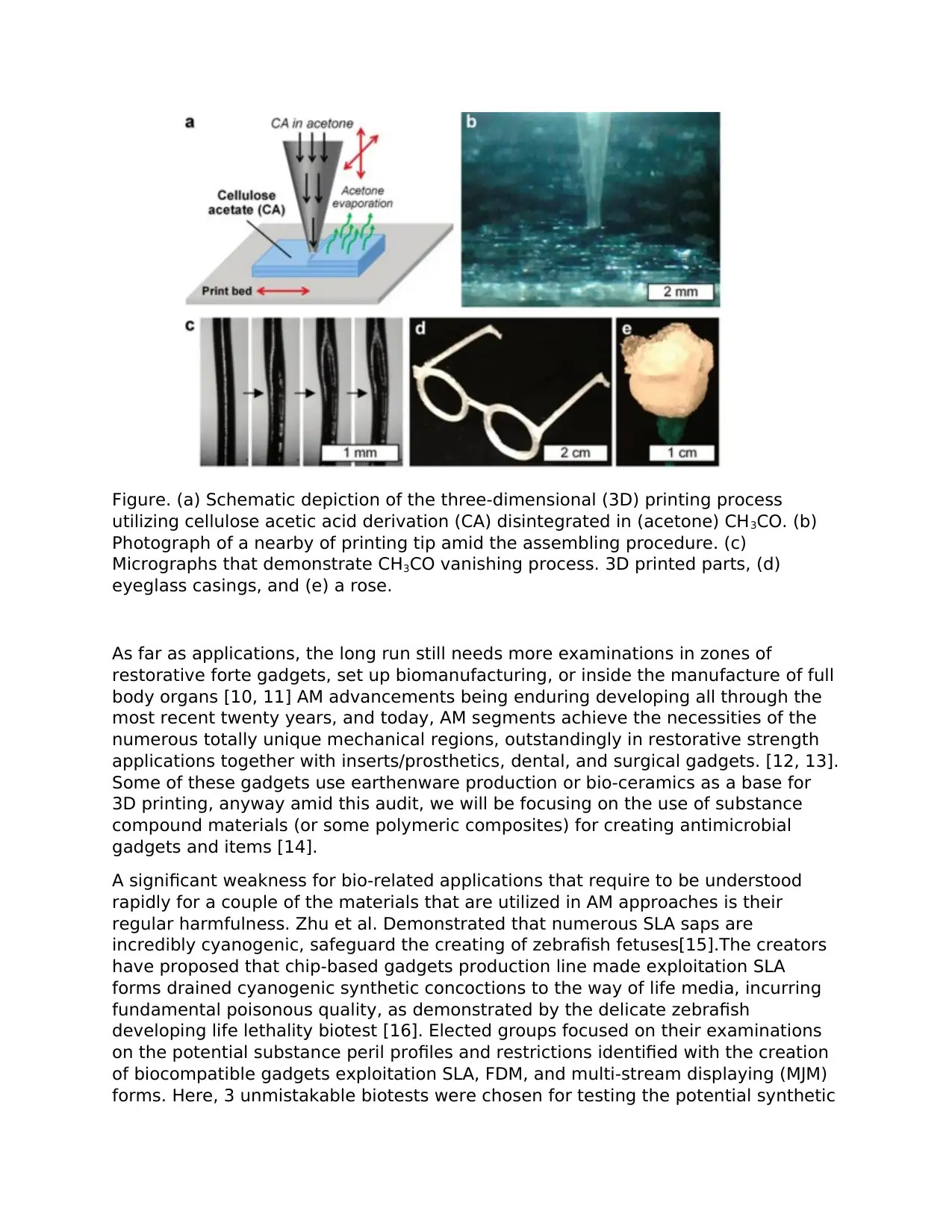
Figure. (a) Schematic depiction of the three-dimensional (3D) printing process
utilizing cellulose acetic acid derivation (CA) disintegrated in (acetone) CH3CO. (b)
Photograph of a nearby of printing tip amid the assembling procedure. (c)
Micrographs that demonstrate CH3CO vanishing process. 3D printed parts, (d)
eyeglass casings, and (e) a rose.
As far as applications, the long run still needs more examinations in zones of
restorative forte gadgets, set up biomanufacturing, or inside the manufacture of full
body organs [10, 11] AM advancements being enduring developing all through the
most recent twenty years, and today, AM segments achieve the necessities of the
numerous totally unique mechanical regions, outstandingly in restorative strength
applications together with inserts/prosthetics, dental, and surgical gadgets. [12, 13].
Some of these gadgets use earthenware production or bio-ceramics as a base for
3D printing, anyway amid this audit, we will be focusing on the use of substance
compound materials (or some polymeric composites) for creating antimicrobial
gadgets and items [14].
A significant weakness for bio-related applications that require to be understood
rapidly for a couple of the materials that are utilized in AM approaches is their
regular harmfulness. Zhu et al. Demonstrated that numerous SLA saps are
incredibly cyanogenic, safeguard the creating of zebrafish fetuses[15].The creators
have proposed that chip-based gadgets production line made exploitation SLA
forms drained cyanogenic synthetic concoctions to the way of life media, incurring
fundamental poisonous quality, as demonstrated by the delicate zebrafish
developing life lethality biotest [16]. Elected groups focused on their examinations
on the potential substance peril profiles and restrictions identified with the creation
of biocompatible gadgets exploitation SLA, FDM, and multi-stream displaying (MJM)
forms. Here, 3 unmistakable biotests were chosen for testing the potential synthetic
utilizing cellulose acetic acid derivation (CA) disintegrated in (acetone) CH3CO. (b)
Photograph of a nearby of printing tip amid the assembling procedure. (c)
Micrographs that demonstrate CH3CO vanishing process. 3D printed parts, (d)
eyeglass casings, and (e) a rose.
As far as applications, the long run still needs more examinations in zones of
restorative forte gadgets, set up biomanufacturing, or inside the manufacture of full
body organs [10, 11] AM advancements being enduring developing all through the
most recent twenty years, and today, AM segments achieve the necessities of the
numerous totally unique mechanical regions, outstandingly in restorative strength
applications together with inserts/prosthetics, dental, and surgical gadgets. [12, 13].
Some of these gadgets use earthenware production or bio-ceramics as a base for
3D printing, anyway amid this audit, we will be focusing on the use of substance
compound materials (or some polymeric composites) for creating antimicrobial
gadgets and items [14].
A significant weakness for bio-related applications that require to be understood
rapidly for a couple of the materials that are utilized in AM approaches is their
regular harmfulness. Zhu et al. Demonstrated that numerous SLA saps are
incredibly cyanogenic, safeguard the creating of zebrafish fetuses[15].The creators
have proposed that chip-based gadgets production line made exploitation SLA
forms drained cyanogenic synthetic concoctions to the way of life media, incurring
fundamental poisonous quality, as demonstrated by the delicate zebrafish
developing life lethality biotest [16]. Elected groups focused on their examinations
on the potential substance peril profiles and restrictions identified with the creation
of biocompatible gadgets exploitation SLA, FDM, and multi-stream displaying (MJM)
forms. Here, 3 unmistakable biotests were chosen for testing the potential synthetic
Paraphrase This Document
Need a fresh take? Get an instant paraphrase of this document with our AI Paraphraser
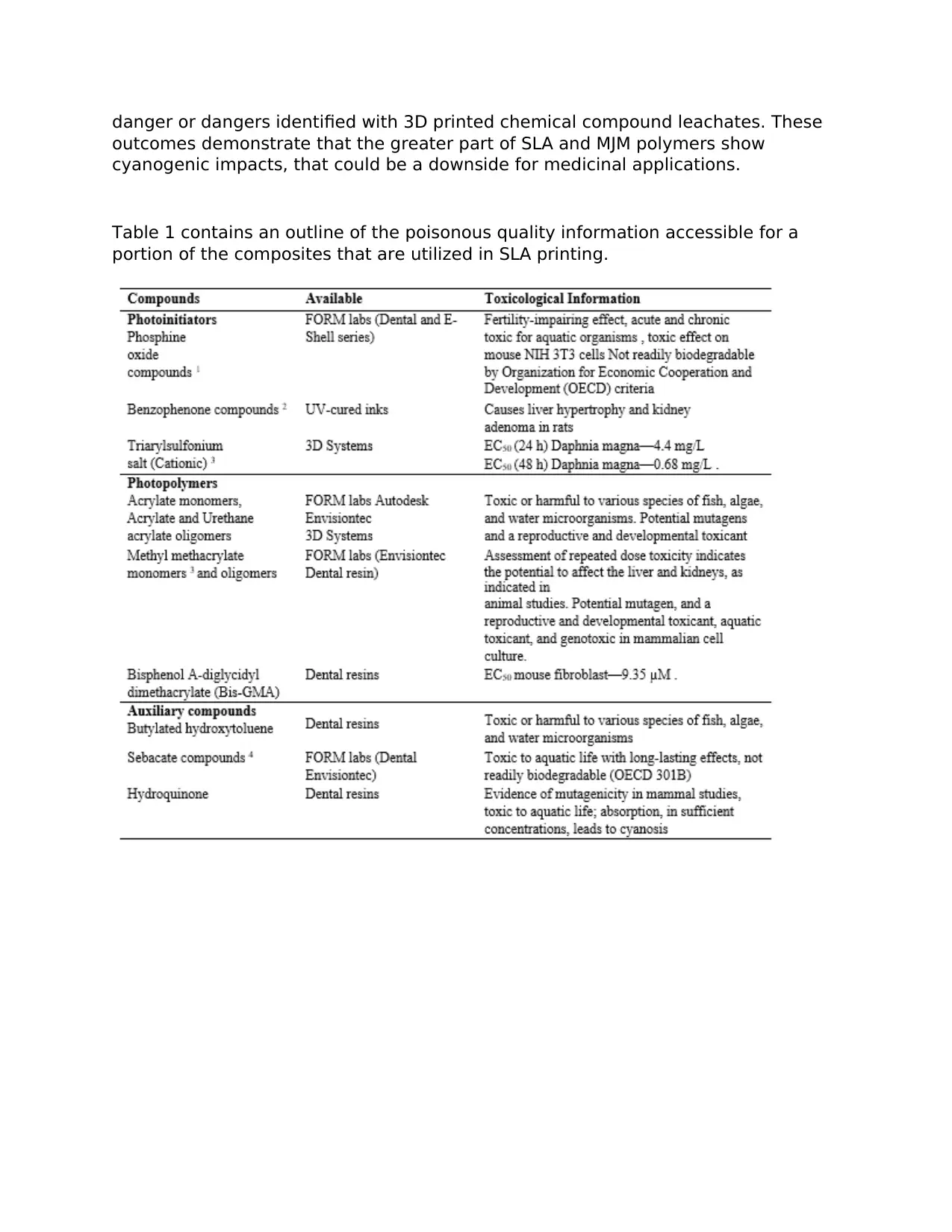
danger or dangers identified with 3D printed chemical compound leachates. These
outcomes demonstrate that the greater part of SLA and MJM polymers show
cyanogenic impacts, that could be a downside for medicinal applications.
Table 1 contains an outline of the poisonous quality information accessible for a
portion of the composites that are utilized in SLA printing.
outcomes demonstrate that the greater part of SLA and MJM polymers show
cyanogenic impacts, that could be a downside for medicinal applications.
Table 1 contains an outline of the poisonous quality information accessible for a
portion of the composites that are utilized in SLA printing.
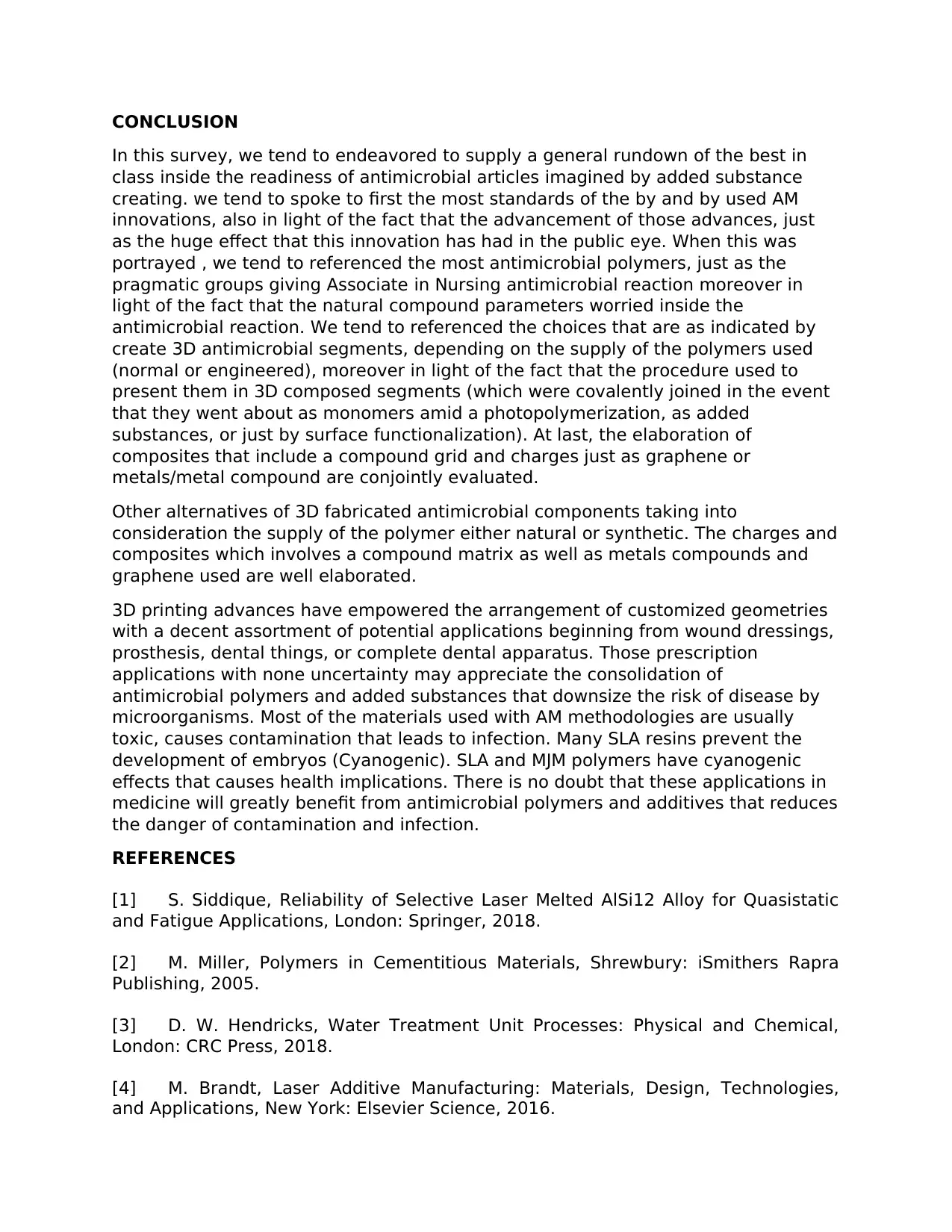
CONCLUSION
In this survey, we tend to endeavored to supply a general rundown of the best in
class inside the readiness of antimicrobial articles imagined by added substance
creating. we tend to spoke to first the most standards of the by and by used AM
innovations, also in light of the fact that the advancement of those advances, just
as the huge effect that this innovation has had in the public eye. When this was
portrayed , we tend to referenced the most antimicrobial polymers, just as the
pragmatic groups giving Associate in Nursing antimicrobial reaction moreover in
light of the fact that the natural compound parameters worried inside the
antimicrobial reaction. We tend to referenced the choices that are as indicated by
create 3D antimicrobial segments, depending on the supply of the polymers used
(normal or engineered), moreover in light of the fact that the procedure used to
present them in 3D composed segments (which were covalently joined in the event
that they went about as monomers amid a photopolymerization, as added
substances, or just by surface functionalization). At last, the elaboration of
composites that include a compound grid and charges just as graphene or
metals/metal compound are conjointly evaluated.
Other alternatives of 3D fabricated antimicrobial components taking into
consideration the supply of the polymer either natural or synthetic. The charges and
composites which involves a compound matrix as well as metals compounds and
graphene used are well elaborated.
3D printing advances have empowered the arrangement of customized geometries
with a decent assortment of potential applications beginning from wound dressings,
prosthesis, dental things, or complete dental apparatus. Those prescription
applications with none uncertainty may appreciate the consolidation of
antimicrobial polymers and added substances that downsize the risk of disease by
microorganisms. Most of the materials used with AM methodologies are usually
toxic, causes contamination that leads to infection. Many SLA resins prevent the
development of embryos (Cyanogenic). SLA and MJM polymers have cyanogenic
effects that causes health implications. There is no doubt that these applications in
medicine will greatly benefit from antimicrobial polymers and additives that reduces
the danger of contamination and infection.
REFERENCES
[1] S. Siddique, Reliability of Selective Laser Melted AlSi12 Alloy for Quasistatic
and Fatigue Applications, London: Springer, 2018.
[2] M. Miller, Polymers in Cementitious Materials, Shrewbury: iSmithers Rapra
Publishing, 2005.
[3] D. W. Hendricks, Water Treatment Unit Processes: Physical and Chemical,
London: CRC Press, 2018.
[4] M. Brandt, Laser Additive Manufacturing: Materials, Design, Technologies,
and Applications, New York: Elsevier Science, 2016.
In this survey, we tend to endeavored to supply a general rundown of the best in
class inside the readiness of antimicrobial articles imagined by added substance
creating. we tend to spoke to first the most standards of the by and by used AM
innovations, also in light of the fact that the advancement of those advances, just
as the huge effect that this innovation has had in the public eye. When this was
portrayed , we tend to referenced the most antimicrobial polymers, just as the
pragmatic groups giving Associate in Nursing antimicrobial reaction moreover in
light of the fact that the natural compound parameters worried inside the
antimicrobial reaction. We tend to referenced the choices that are as indicated by
create 3D antimicrobial segments, depending on the supply of the polymers used
(normal or engineered), moreover in light of the fact that the procedure used to
present them in 3D composed segments (which were covalently joined in the event
that they went about as monomers amid a photopolymerization, as added
substances, or just by surface functionalization). At last, the elaboration of
composites that include a compound grid and charges just as graphene or
metals/metal compound are conjointly evaluated.
Other alternatives of 3D fabricated antimicrobial components taking into
consideration the supply of the polymer either natural or synthetic. The charges and
composites which involves a compound matrix as well as metals compounds and
graphene used are well elaborated.
3D printing advances have empowered the arrangement of customized geometries
with a decent assortment of potential applications beginning from wound dressings,
prosthesis, dental things, or complete dental apparatus. Those prescription
applications with none uncertainty may appreciate the consolidation of
antimicrobial polymers and added substances that downsize the risk of disease by
microorganisms. Most of the materials used with AM methodologies are usually
toxic, causes contamination that leads to infection. Many SLA resins prevent the
development of embryos (Cyanogenic). SLA and MJM polymers have cyanogenic
effects that causes health implications. There is no doubt that these applications in
medicine will greatly benefit from antimicrobial polymers and additives that reduces
the danger of contamination and infection.
REFERENCES
[1] S. Siddique, Reliability of Selective Laser Melted AlSi12 Alloy for Quasistatic
and Fatigue Applications, London: Springer, 2018.
[2] M. Miller, Polymers in Cementitious Materials, Shrewbury: iSmithers Rapra
Publishing, 2005.
[3] D. W. Hendricks, Water Treatment Unit Processes: Physical and Chemical,
London: CRC Press, 2018.
[4] M. Brandt, Laser Additive Manufacturing: Materials, Design, Technologies,
and Applications, New York: Elsevier Science, 2016.
⊘ This is a preview!⊘
Do you want full access?
Subscribe today to unlock all pages.

Trusted by 1+ million students worldwide
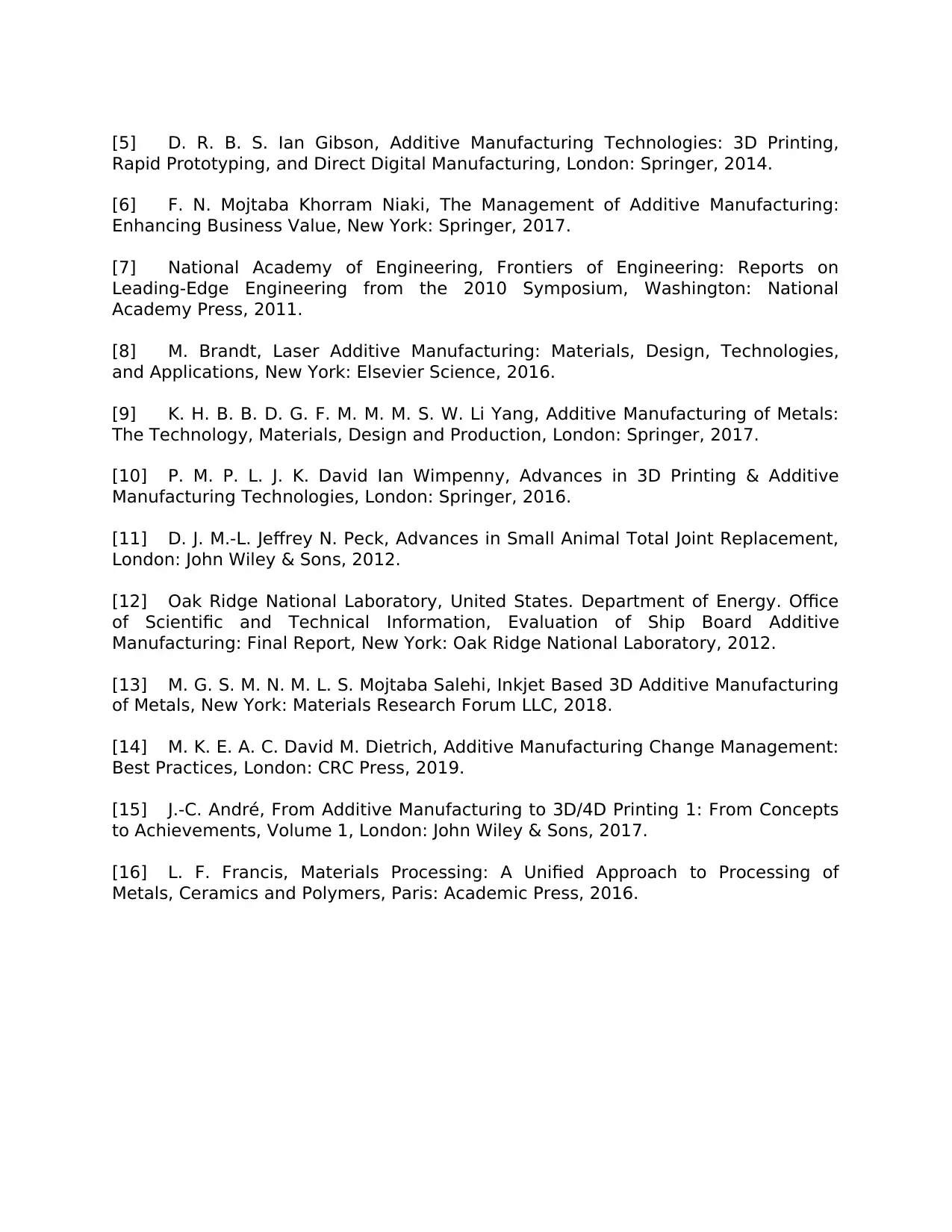
[5] D. R. B. S. Ian Gibson, Additive Manufacturing Technologies: 3D Printing,
Rapid Prototyping, and Direct Digital Manufacturing, London: Springer, 2014.
[6] F. N. Mojtaba Khorram Niaki, The Management of Additive Manufacturing:
Enhancing Business Value, New York: Springer, 2017.
[7] National Academy of Engineering, Frontiers of Engineering: Reports on
Leading-Edge Engineering from the 2010 Symposium, Washington: National
Academy Press, 2011.
[8] M. Brandt, Laser Additive Manufacturing: Materials, Design, Technologies,
and Applications, New York: Elsevier Science, 2016.
[9] K. H. B. B. D. G. F. M. M. M. S. W. Li Yang, Additive Manufacturing of Metals:
The Technology, Materials, Design and Production, London: Springer, 2017.
[10] P. M. P. L. J. K. David Ian Wimpenny, Advances in 3D Printing & Additive
Manufacturing Technologies, London: Springer, 2016.
[11] D. J. M.-L. Jeffrey N. Peck, Advances in Small Animal Total Joint Replacement,
London: John Wiley & Sons, 2012.
[12] Oak Ridge National Laboratory, United States. Department of Energy. Office
of Scientific and Technical Information, Evaluation of Ship Board Additive
Manufacturing: Final Report, New York: Oak Ridge National Laboratory, 2012.
[13] M. G. S. M. N. M. L. S. Mojtaba Salehi, Inkjet Based 3D Additive Manufacturing
of Metals, New York: Materials Research Forum LLC, 2018.
[14] M. K. E. A. C. David M. Dietrich, Additive Manufacturing Change Management:
Best Practices, London: CRC Press, 2019.
[15] J.-C. André, From Additive Manufacturing to 3D/4D Printing 1: From Concepts
to Achievements, Volume 1, London: John Wiley & Sons, 2017.
[16] L. F. Francis, Materials Processing: A Unified Approach to Processing of
Metals, Ceramics and Polymers, Paris: Academic Press, 2016.
Rapid Prototyping, and Direct Digital Manufacturing, London: Springer, 2014.
[6] F. N. Mojtaba Khorram Niaki, The Management of Additive Manufacturing:
Enhancing Business Value, New York: Springer, 2017.
[7] National Academy of Engineering, Frontiers of Engineering: Reports on
Leading-Edge Engineering from the 2010 Symposium, Washington: National
Academy Press, 2011.
[8] M. Brandt, Laser Additive Manufacturing: Materials, Design, Technologies,
and Applications, New York: Elsevier Science, 2016.
[9] K. H. B. B. D. G. F. M. M. M. S. W. Li Yang, Additive Manufacturing of Metals:
The Technology, Materials, Design and Production, London: Springer, 2017.
[10] P. M. P. L. J. K. David Ian Wimpenny, Advances in 3D Printing & Additive
Manufacturing Technologies, London: Springer, 2016.
[11] D. J. M.-L. Jeffrey N. Peck, Advances in Small Animal Total Joint Replacement,
London: John Wiley & Sons, 2012.
[12] Oak Ridge National Laboratory, United States. Department of Energy. Office
of Scientific and Technical Information, Evaluation of Ship Board Additive
Manufacturing: Final Report, New York: Oak Ridge National Laboratory, 2012.
[13] M. G. S. M. N. M. L. S. Mojtaba Salehi, Inkjet Based 3D Additive Manufacturing
of Metals, New York: Materials Research Forum LLC, 2018.
[14] M. K. E. A. C. David M. Dietrich, Additive Manufacturing Change Management:
Best Practices, London: CRC Press, 2019.
[15] J.-C. André, From Additive Manufacturing to 3D/4D Printing 1: From Concepts
to Achievements, Volume 1, London: John Wiley & Sons, 2017.
[16] L. F. Francis, Materials Processing: A Unified Approach to Processing of
Metals, Ceramics and Polymers, Paris: Academic Press, 2016.
1 out of 7
Your All-in-One AI-Powered Toolkit for Academic Success.
+13062052269
info@desklib.com
Available 24*7 on WhatsApp / Email
![[object Object]](/_next/static/media/star-bottom.7253800d.svg)
Unlock your academic potential
Copyright © 2020–2025 A2Z Services. All Rights Reserved. Developed and managed by ZUCOL.